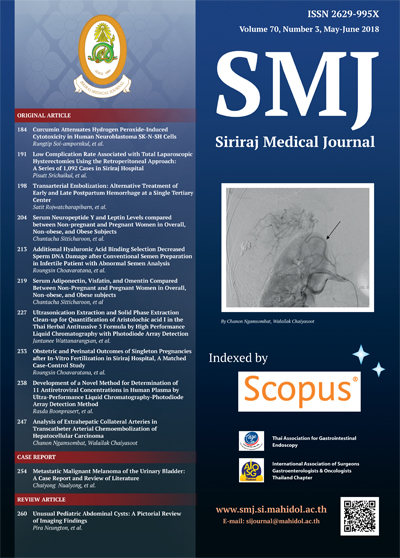Obstetric and Perinatal Outcomes of Singleton Pregnancies After in-vitro Fertilization in Siriraj Hospital, A Matched Case-Control Study
Keywords:
IVF; Natural conception; pregnancy outcomes; neonatal outcomes; cesareanAbstract
Objective: To compare obstetric and perinatal outcomes between singletons born after IVF and natural conception.
Methods: A total of 141 singleton pregnancies conceived by IVF were included. Another 141 singleton pregnancies conceived naturally were randomly selected as comparison group, matched by age. Data were retrospectively extracted from medical records, including baseline characteristics and delivery data. Various characteristics, including pregnancy and neonatal outcomes were compared between groups.
Results: Women in IVF group were more likely to be nulliparous and had previous miscarriage (88.7% vs. 76.6%,0=0.003; and 26.2% vs. 14.8%, p=0.018, respectively). Underlying diseases and complications during pregnancy were comparable between the 2 groups. Mean gestational age was lower in IVF group (37.9 ± 2.0 vs. 38.4 ± 1.6, p=0.008),but without clinical significance. Primary cesarean section was significantly more common among women in IVF group (74.4% vs. 54.6%, p<0.001) and the majority were elective cases (61.9% vs. 23.4%, p<0.001). There were no significant differences in terms of rates of preterm labor, birth weight, low birth weight, small for gestational age, neonatal intensive care unit admissions, and perinatal mortality.
Conclusion: Singleton pregnancies after IVF were not associated with higher risks of adverse obstetric and perinatal outcomes, compared with naturally conceived group, but IVF pregnancies are associated with a high rate of cesarean sections.
Downloads
Published
How to Cite
Issue
Section
License
Authors who publish with this journal agree to the following conditions:
Copyright Transfer
In submitting a manuscript, the authors acknowledge that the work will become the copyrighted property of Siriraj Medical Journal upon publication.
License
Articles are licensed under a Creative Commons Attribution-NonCommercial-NoDerivatives 4.0 International License (CC BY-NC-ND 4.0). This license allows for the sharing of the work for non-commercial purposes with proper attribution to the authors and the journal. However, it does not permit modifications or the creation of derivative works.
Sharing and Access
Authors are encouraged to share their article on their personal or institutional websites and through other non-commercial platforms. Doing so can increase readership and citations.











